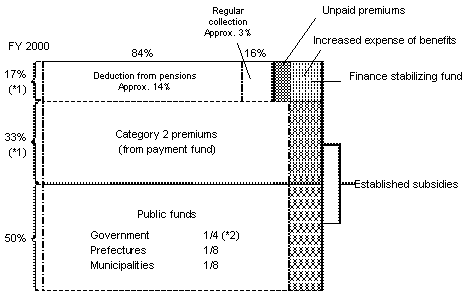
2.The Long-term care Insurance System
(1) Aims for introducing the system
(2) Outline of the System
2) The insured, beneficiaries and premiums
| Category 1 insured persons | Category 2 insured persons | |||||||||||||
| Eligible persons | Persons aged 65 or over | Persons aged 40 to 64 who are insured by health care insurance | ||||||||||||
| Beneficiaries |
|
Those who have become bed-ridden, dementia, and/or frail be- cause of specific age-related diseases such as early-stage dementia, cerebro-vascular disorder, etc. (*) | ||||||||||||
| Premiums | Collected by municipalities | Collected with premiums for health care insurance by health care insurers and paid in lump sums | ||||||||||||
| Method of levying and collection |
|
|
| (*) | For the time being, public funds will be used to provide young disabled persons with comprehensively programmed long-term care services, etc. in accordance with the Government Action Plan for Persons with Disabilities. |
(3) Procedures for use
| 1) | Municipalities shall provide long-term care requirement certification and support requirement certification based on the screening judgement results of the long-term care approval board.
The long-term care approval board will investigate the mental and physical condition of the insured person and make a screening judgement based on the opinions of a regular doctor. (The screening judgement can be entrusted to prefectures.)
Limit for benefits paid for home long-term care services (To be unified in January 2002)
| ||||||||||||||||||||||||||||||||||||||||||||||
| 2) | From the standpoint of providing comprehensive and planned service to accommodate the policyholder's demands, it is fundamental that a long-term care service plan (care plan) is decided. | ||||||||||||||||||||||||||||||||||||||||||||||
(4) Insurance benefits
| In-home service | Services at facilities | |||||||||||||||||||||||||||
| Persons requiring long-term care |
|
|
||||||||||||||||||||||||||
| Persons requiring support | Same as above (excluding care service with mutual support for the elderly with dementia) | N/A |
(5) Costs
| 1) | Out-of-pocket payment at a fixed rate (10% of the cost of the insured services) and a standard charge for meals imposed on users of facility services (such as special nursing homes for the elderly). |
| 2) | There is an upper limit of the above out-of-pocket payment. |
| 3) | The upper limit of the out-of-pocket payment and standard charge for meals is set lower for people with low income. |
| Upper limit of 10% charge covered by high long-term care service cost | Standard charges for meals | |
| Non-low income persons | 37,200 yen/month | 23,400 yen/month(780 yen/day) |
| Municipal tax-exempted households | 24,600 yen/month | 15,000 yen/month(500 yen/day)) |
| Old-Age Welfare Pension recipients, etc. | 15,000 yen/month | 9,000 yen/month(300 yen/day)) |
| * | Reduction and exemption measures for costs during the 5-year period following implementation, for persons resident in special nursing homes for the elderly at the time of implementation, shall be negotiated in response to their ability to pay |
(6) Expenses

| *1 | Percentage based on the population ratio of category 1 and category 2 insured persons. | |||||||
| *2 | The government will be provided 5% to make adjustments for differences in municipalities' financial capabilities. (Percentage of subsidies are differ from each municipalities)
|
| ☆ | Intermittent financial management shall be introduced, and premiums for category 1 insured persons will be revised once every 3 years. |
(7) Insurance Premiums
| Level | Eligible Persons | Premium | (Ref.) Estimated percentage of eligible persons | ||||
| 1 |
|
Basic amount x 0.5 | Approx. 2% | ||||
| 2 | Municipal tax-exempted households | Basic amount x 0.75 | Approx. 29% | ||||
| 3 | Municipal tax-exempted persons | Basic amount x 1 | Approx. 43% | ||||
| 4 | Municipal tax payer (The insured person's total amount of income is less than 2,500,000 yen.) | Basic amount x 1.25 | Approx. 16% | ||||
| 5 | Municipal tax payer (The insured person's total amount of income is 2,500,000 yen or more.) | Basic amount x 1.5 | Approx. 10% |
(8) Preparation of the basis for provision of long-term care services
| 1) | In order to promote infrastructure of a long-term care service to progress in a systematic manner, municipalities must determine their plans for long-term care insurance services and prefectures must decide on their long-term care services and benefits respectively, based on fundamental policies decided by the government. |
| 2) | When municipalities are to plan or to change the municipal long-term care insurance service plan, measures to reflect insured persons' opinions shall be taken. |
| 3) | Municipalities that have difficulty securing the standard levels of benefits for home services determined by the government, can fix a standard level that is lower than the appropriate level, and raise this gradually to the level determined by regulations 5 years after implementation. |
(9) Considerations for stabilizing system operations
<Considerations of financial aspects>
| 1) | The government will provide subsidies equivalent to 50% of the administrative expenses incurred for the newly added matters of long-term care requirement certification etc. |
| 2) | Finance stabilizing funds shall be granted or loaned to prefectures, (the government, prefectures and Category 1 premiums shall each provide one third of the revenues), to make good financial deficits caused by increased payments resulting from benefits surpassing estimates, and declined rates of premium payments. |
<Considerations of business implementation aspects>
(10) Implementation
(11) Considerations
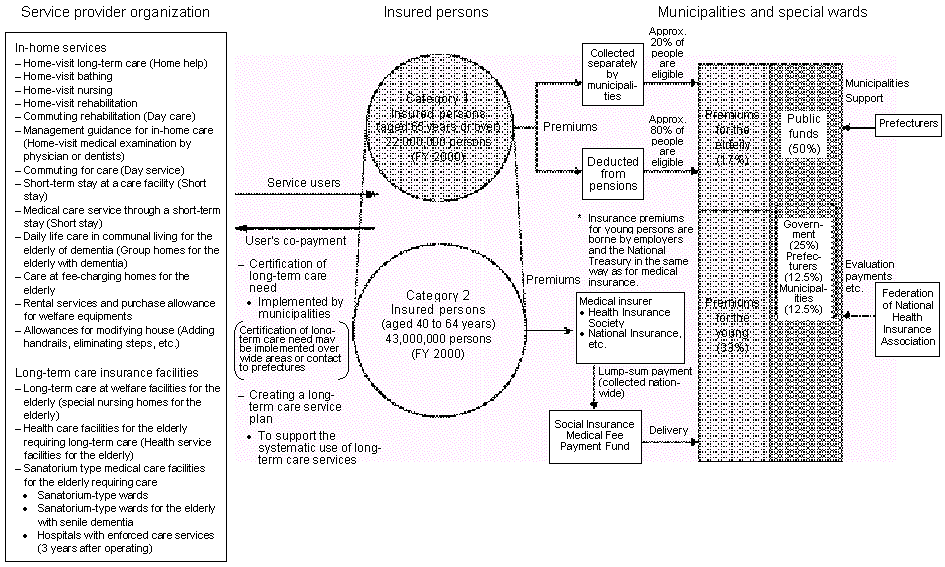
|
The ratio of elderly persons increases from "one out of six people" to "one out of four people" |
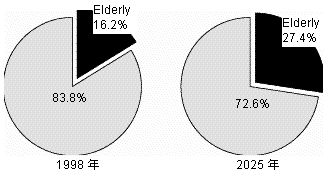
|
The number of bedridden elderly / suffered from dementia are rapidly increasing |
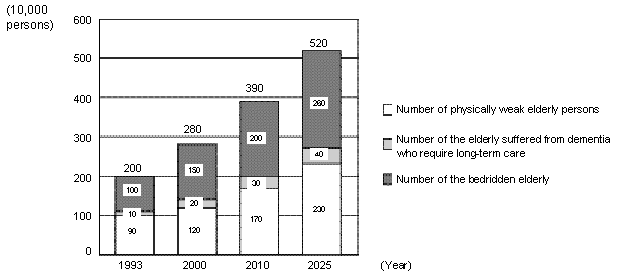
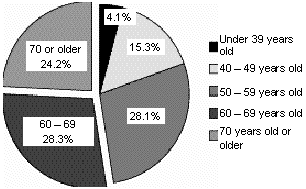 |
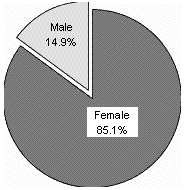 |
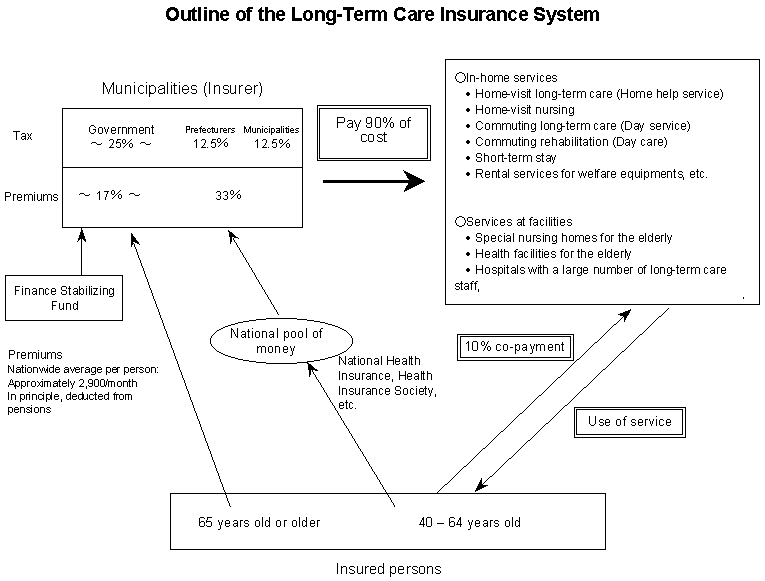
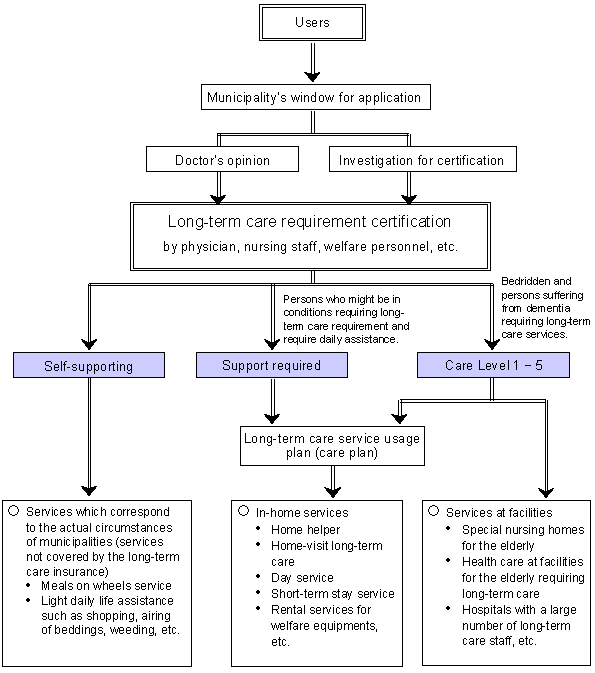
| Previous system | Long-term care insurance system | |||||||||||||||
|
→ | Users can choose the type of service and facilities they want to use. | ||||||||||||||
|
→ | Users will make a long-term care service usage plan (care plan) and use medical care and welfare services comprehensively. | ||||||||||||||
|
→ | Services provided by various organizations such as private companies, agricultural cooperatives, livelihood cooperatives, and volunteer organizations, etc. | ||||||||||||||
|
→ | Users will pay 10% charge for the service regardless of their income.
|
|
Finance stabilizing fund (source of revenue → Government: prefecturers: Category 1 premiums - 1: 1:1) Loan etc. from fund as a result of financial deficit incurred from increased expense of benefits and non-payment of premiums |
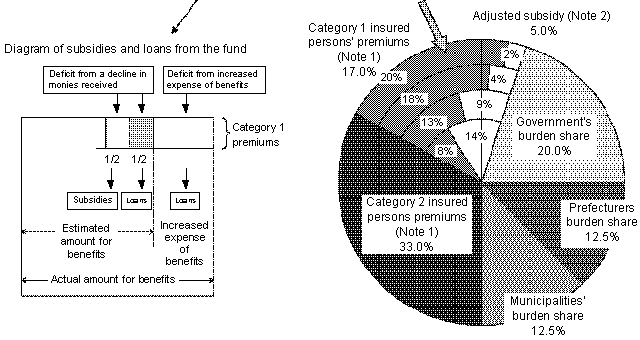
| Notes: 1. | The ratio of category 1 insured persons: Category 2 insured persons was assumed for FY 2000. |
| 2. | Adjusted subsidies will be provided in relation to the percentage of latter stage elderly persons in each municipality, and their incomes, etc. Nationwide, this will amount to approx. 5% of the overall subsidy. However, subsidy adjustment rates are examples. |